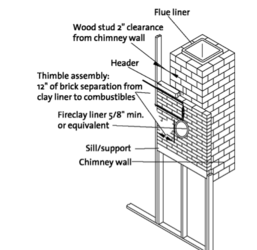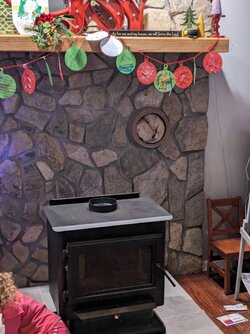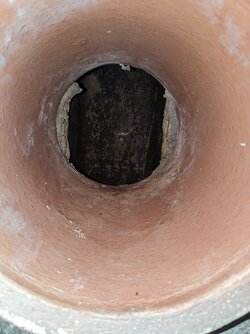I've lurked on here on and off for a few years. I'm finally getting to the culmination of a long process and I'm starting to get paranoid. This all started when we were renovating our house. Originally, there was a wood furnace in the basement with a vent straight into the living room floor. Our contractor cut into the chimney on the main floor and installed a 8.25" ID clay crock/thimble because we wanted a wood stove in the future. At the time I knew nothing about wood stoves/clearances/etc. The chimney is clay lined 6X6 tiles.
A while back I got an Englander 13NC, and it has been sitting for a while waiting on me to get a hearth pad built. I had an appropriate pad built Micore and tile based on reading this site. Now the stove is in place and I need to connect it to my chimney, this is where I'm getting paranoid. I've read the post about crock thimbles and how they might be installed incorrectly, but I have no way to check. We have a rock wall up where the stove/thimble go, and the chimney side is brick, so I don't know what is in the middle with the framing. I've had 2 different installers come and quote an install, but nobody has mentioned a method of connecting. I live in NE TN, so there aren't many people around who deal with stoves for heating and I'm not sure how qualified the installers are. Is there any kind of insulated thimble that will fit into my existing crock? Is something like this what I need? I would prefer to DIY if I can, but I also don't want to burn my house down.
A while back I got an Englander 13NC, and it has been sitting for a while waiting on me to get a hearth pad built. I had an appropriate pad built Micore and tile based on reading this site. Now the stove is in place and I need to connect it to my chimney, this is where I'm getting paranoid. I've read the post about crock thimbles and how they might be installed incorrectly, but I have no way to check. We have a rock wall up where the stove/thimble go, and the chimney side is brick, so I don't know what is in the middle with the framing. I've had 2 different installers come and quote an install, but nobody has mentioned a method of connecting. I live in NE TN, so there aren't many people around who deal with stoves for heating and I'm not sure how qualified the installers are. Is there any kind of insulated thimble that will fit into my existing crock? Is something like this what I need? I would prefer to DIY if I can, but I also don't want to burn my house down.





